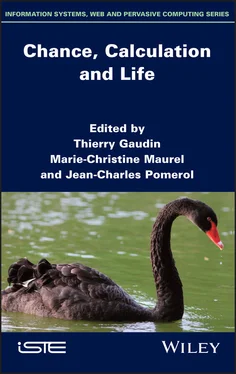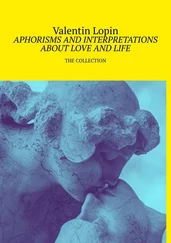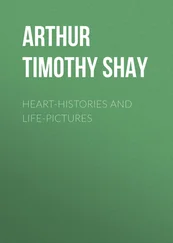Chance, Calculation and Life
Здесь есть возможность читать онлайн «Chance, Calculation and Life» — ознакомительный отрывок электронной книги совершенно бесплатно, а после прочтения отрывка купить полную версию. В некоторых случаях можно слушать аудио, скачать через торрент в формате fb2 и присутствует краткое содержание. Жанр: unrecognised, на английском языке. Описание произведения, (предисловие) а так же отзывы посетителей доступны на портале библиотеки ЛибКат.
- Название:Chance, Calculation and Life
- Автор:
- Жанр:
- Год:неизвестен
- ISBN:нет данных
- Рейтинг книги:3 / 5. Голосов: 1
-
Избранное:Добавить в избранное
- Отзывы:
-
Ваша оценка:
- 60
- 1
- 2
- 3
- 4
- 5
Chance, Calculation and Life: краткое содержание, описание и аннотация
Предлагаем к чтению аннотацию, описание, краткое содержание или предисловие (зависит от того, что написал сам автор книги «Chance, Calculation and Life»). Если вы не нашли необходимую информацию о книге — напишите в комментариях, мы постараемся отыскать её.
Chance, Calculation and Life — читать онлайн ознакомительный отрывок
Ниже представлен текст книги, разбитый по страницам. Система сохранения места последней прочитанной страницы, позволяет с удобством читать онлайн бесплатно книгу «Chance, Calculation and Life», без необходимости каждый раз заново искать на чём Вы остановились. Поставьте закладку, и сможете в любой момент перейти на страницу, на которой закончили чтение.
Интервал:
Закладка:
If the reader were observing Burgess fauna, some 520 million years ago (Gould 1989), they would not be able to attribute probabilities to the changes of survival of Anomalocaris or Hallucigenia, or to one of the little chordates, nor their probabilities to become a squid, a bivalve or a kangaroo. To the challenges of synchronic measurement, proper to physical state determined systems, such as the ones we examined above, one has to add the even harder approximation of diachronic measurement, in view of the relevance of history in the determination of the biological state of affairs (Longo 2017).
Note that in section 1.4we could have made a synthetic prediction: phenotypic complexity increases along evolution by a random, but asymmetric, diffusion. This conclusion would have been based on a global evaluation, a sum of all the numbers we associated with biological forms (fractal dimensions, networks’ numbers, tissue folding … all summed up). In no way, however, can you “project” this global value into specific phenotypes. There is no way to know if the increasing complexity could be due to the transformation of the lungs of early tetrapods into swim bladders and gills (branchia), or of their “twin-jointed jaw” into the mammalian auditory ossicles (Luo 2011).
Can AIT be of any help to meet this challenge? From a highly epistemic perspective, one may say that the phenotypes cannot be described before they appear. Thus, they form an incompressible list of described/describable phenotypes, at each moment of the evolutionary process. It seems hard to turn such a contingent/linguistic statement into an objective scientific analysis.
In contrast to AIT, in which randomness is developed for infinite sequences of numbers, in a measurement independent way, any study of randomness in a specific context, physical or biological, for example, depends on the intended theory which includes its main assumptions (see, for example, section 1.3for the “principles” used in the analysis of quantum randomness and for the theory-and-measurement-dependent notion of the predictor).
As a consequence, our focus on unpredictability and randomness in natural sciences, where access to knowledge crucially requires physical or biological measurement, cannot and should not be interpreted as an argument that “the world is random” and even less that it is “computable” – we, historical and linguistic humans, effectively write our theories and compute them in order to predict (see Calude et al . 2012 for a discussion on the hypothesis of a lawless (physical) Universe).
We used (strong forms of) relative unpredictability as a tool to compare different forms of determination and stability in natural sciences, sometimes by a conceptual or mathematical duality (showing the “relevance of negative results”), other times by stressing the role of randomness in the robustness or resilience of phenomena. The ways we acquire knowledge may be enlightened by this approach, also in view of the role of symmetries and invariance in mathematical modeling and of the strong connections between spontaneous symmetry breaking and random events discussed in Longo and Montévil (2015).
1.8. Acknowledgments
The authors have been supported in part by Marie Curie FP7-PEOPLE-2010-IRSES Grant and have benefitted from discussions and collaboration with A. Abbott, S. Galatolo, M. Hoyrup, T. Paul and K. Svozil. We also thank the referees for their excellent comments and suggestions. We also warmly thank Springer Editions for authorizing the translation of the original article (Classical, Quantum and Biological Randomness as Relative Unpredictability. Invited Paper , special issue of Natural Computing , Volume 15, Issue 2, pp. 263–278, Springer, March 2016) and Louis Ter Ovanessian who provided the translation.
1.9. References
Abbott, A.A., Calude, C.S., Conder, J., Svozil, K. (2012). Strong Kochen-Specker theorem and incomputability of quantum randomness. Physical Review A , 86, 062109 [Online]. Available at: http://dx.doi.org/10.1103/PhysRevA.86.062109[Accessed January 2021].
Abbott, A.A., Calude, C.S., Svozil, K. (2014a). Value-indefinite observables are almost everywhere. Physical Review A , 89, 032109 [Online]. Available at: http://dx.doi.org/10.1103/PhysRevA.89.032109[Accessed January 2021].
Abbott, A.A., Calude, C.S., Svozil, K. (2014b). Value indefiniteness is almost everywhere. Physical Review A , 89(3), 032109 [Online]. Available at: http://arxiv.org/abs/1309.7188[Accessed January 2021].
Abbott, A.A., Calude, C.S., Svozil, K. (2015a). A non-probabilistic model of relativised predictability in physics. Information , 6, 773–789.
Abbott, A.A., Calude, C.S., Svozil, K. (2015b). On the unpredictability of individual quantum measurement outcomes. In Fields of Logic and Computation II – Essays Dedicated to Yuri Gurevich on the Occasion of His 75th Birthday, Lecture Notes in Computer Science , Beklemishev, L.D., Blass, A., Dershowitz, N., Finkbeiner, B., Schulte, W. (eds). Springer, 9300, 69–86 [Online]. Available at: http://dx.doi.org/10.1007/978-3-319-23534-9_4[Accessed January 2021].
Anthes, G. (2011). The quest for randomness. Communications of the ACM , 54(4), 13–15. Arjun, R. and van Oudenaarden, R. (2008). Stochastic gene expression and its consequences. Cell , 135(2), 216–226.
Bailly, F. and Longo, G. (2009). Biological organization and anti-entropy. Journal of Biological Systems , 17(1), 63–96.
Ball, P. (2011). The dawn of quantum biology. Nature , 474, 272–274.
Barbara Bravi, G.L. (2015). The unconventionality of nature: Biology, from noise to functional randomness. In Unconventional Computation and Natural Computation Conference , Calude, C.S., Dinneen, M.J. (eds). Springer, LNCS 9252 [Online]. Available at: http://www.di.ens.fr/users/longo/files/CIM/Unconventional-NatureUCNC2015.pdf[Accessed January 2021].
Bell, J.S. (1966). On the problem of hidden variables in quantum mechanics. Reviews of Modern Physics , 38, 447–452 [Online]. Available at: http://dx.doi.org/10.1103/RevModPhys.38.447.
Borel, E. (1909). Les probabilités dénombrables et leurs applications arithmétiques. Rendiconti del Circolo Matematico di Palermo (1884–1940) , 27, 247–271 [Online]. Available at: http://dx.doi.org/10.1007/BF03019651[Accessed January 2021].
Bork, P., Jensen, L.J., von Mering, C., Ramani, A.K., Lee, I., Marcotte, E.M. (2004). Protein interaction networks from yeast tohuman. Current Opinion in Structural Biology , 14, 292–299.
Born, M. (1926). Zur Quantenmechanik der Stoßvorg änge. Zeitschrift für Physik , 37, 863–867 [Online]. Available at: http://dx.doi.org/10.1007/BF01397477[Accessed January 2021].
Born, M. (1969). Physics in my Generation , 2nd edition. Springer, New York.
Bros, J. and Iagolnitzer, D. (1973). Causality and local mathematical analyticity: Study. Ann. Inst. Henri Poincaré , 18(2), 147–184.
Buiatti, M. (2003). Functional dynamics of living systems and genetic engineering. Rivista di biologia , 97(3), 379–408.
Buiatti, M. and Longo, G. (2013). Randomness and multilevel interactions in biology. Theory Bioscience , 132, 139–158.
Calude, C. (2002). Information and Randomness – An Algorithmic Perspective , 2nd edition. Springer, Berlin.
Calude, C.S. and Staiger, L. (2018). Liouville numbers, Borel normality and algorithmic randomness. Theory of Computing Systems , 62(7), 1573–1585.
Calude, C.S. and Svozil, K. (2008). Quantum randomness and value indefiniteness. Advanced Science Letters , 1(2), 165–168 [Online]. Available at: http://dx.doi.org/10.1166/asl.2008.016.EprintarXiv:quant-ph/0611029[Accessed January 2021].
Читать дальшеИнтервал:
Закладка:
Похожие книги на «Chance, Calculation and Life»
Представляем Вашему вниманию похожие книги на «Chance, Calculation and Life» списком для выбора. Мы отобрали схожую по названию и смыслу литературу в надежде предоставить читателям больше вариантов отыскать новые, интересные, ещё непрочитанные произведения.
Обсуждение, отзывы о книге «Chance, Calculation and Life» и просто собственные мнения читателей. Оставьте ваши комментарии, напишите, что Вы думаете о произведении, его смысле или главных героях. Укажите что конкретно понравилось, а что нет, и почему Вы так считаете.












